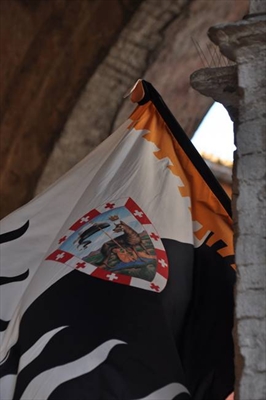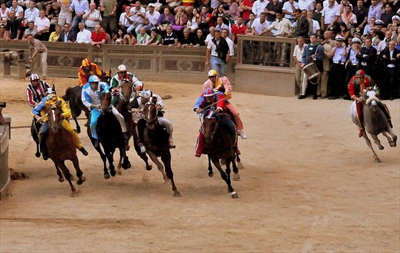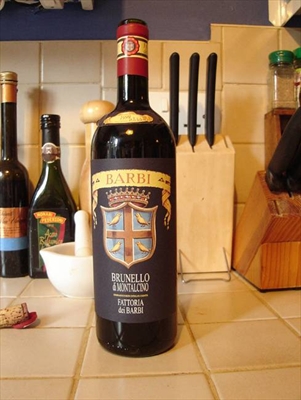Klara Barcic
At this time of the year many tourists head for Siena. It is not only its beauty, and its historic centre, declared by UNESCO a World Heritage Site, that attract many visitors every year, but the city is also famous for the well known palio, a horce race traditionally called the Carriera, which is held at the fan-shaped Piazza del Campo twice a year: July 2 (Palio di Provenzano in honour of the Madonna di Provenzano) and August 16 (Palio dell’Assunta in honor of Our Lady of the Assumption). An event which is not to be missed and which gives the 17 contradas of Siena an opportunity to compete against each other.

Photo by Alessandro Silipo
Siena is divided into 17 contradas. A contrada is a precisely defined district or quarter, established in 1729 by the Governor of Siena, a Grand Princess of Tuscany Violante Beatrice of Bavaria. Each contrada has its own history, is named after an animal or symbol, and boasts its own patron saint, church, flag, fountain and set of heraldic and semi-mythological associations.
The tradition of the palio race goes back to the 12th century. Initially, it was run in honour of St. Boniface, after whom the first cathedral of Siena in Castelvecchio was named. At that time the palio was one of the many events that animated life in the city. The main difference between the first and so-called modern palio is that in the first palio all those who wanted to show off their supremacy took part: jockeys, feudatories, the gentlementry, whereas the modern palio is called the Palio of Contradas and has its origins between the 16th and 17th centuries.
The official start was July 2, 1656 in honour of the Madonna di Provenzano, a statue of the Virgin Mary, which was shot at and broken by a Spanish soldier. It is important to point out that even if the two palio races are identical, each represents a separate event and the people of the contrada would count a year from the palio race in July of the current year to the palio race in July of the next year and the same with the palio run in August.
Even though the palio fever may affect thousands of tourists who flock to the city during the race, the palio is exclusively a matter of contradas and their members. Preparations for the palio start on June 29 and August 13, three days before the race. Ten contradas out of 17 take part in the first race whilst the remaining seven contradas plus three from the July palio run on August 16. Ten horses for the race are chosen on the first day during the first trial by the Captains (elected leaders) of the contradas participating in the palio race. After that each contrada is assigned a horse by a draw. The draw is a moment of great tension because only after a horse has been assigned, a contrada can develop its own race strategy.
It must be noted that the palio focuses on the horse and not on the jockey. The horse may win even without his jockey. There are six trials before the race: five are run on days preceding the palio whilst the sixth (known as the Provaccia) is run in the morning of the same day of the palio. In the evening before the race, after the fifth trial, the so-called Prova Generale, each contrada will lay out rows of long tables in its largest square, illuminated by hundreds of torches and lanterns. It is, at the same time, an occasion to socialize but also to intensify rivalries.

Photo by Stefano Micheli
And now, here we go! On July 2 and August 16 the city awakens at dawn. The big day starts with the celebration of the Jockey’s (Fantino) Mass in the gothic Chapel at the foot of the Mangia Tower that dominates Piazza del Campo. The Chapel was built in 1352 as a vow to the Holy Virgin by the Sienese survivors of the Black Death. At 10:00 am each contrada announces who its jockey is and from that moment on no exchange of the jockeys is possible.
The jockeys and the horses later receive God’s benediction in the chapel of the competing contradas. Soon after the benediction the historical parade, a lively display of coloured medieval costumes preceded by the flagbearer of the Commune, departs from the Prefettura and finishes its route at the Piazza del Campo. At 7:20 pm in July and at 7:00 pm in August the long-awaited moment finally arrives. Everybody, both tourists and members of the contradas, follow the neverending moments of the race with bated breath and trepidation. The winner, the horse that first crosses the finish line, is given the drappellone (which the Sienese call the cencio), a hand painted silk standard depicting the Virgin, the emblems of ten competing contradas, heraldry of the Commune and the city.
After the victory members of the winning contrada head towards the church; in July, the Te Deum, prayer of thanksgiving for the victory and the outstanding horse, is celebrated in the Church of the Piazza di Provenzano, whilst in August victory is celebrated in Siena’s cathedral, the Duomo, dedicated to the Holy Mary of the Assumption.

The Palio race, photo by Stefano Micheli
It is certainly too late to enjoy the palio of July 2, but there is still time to organize a trip to Siena for the palio of August 16. Make sure to buy a ticket for the race well in advance, because generally it is an impossible mission to get a ticket. Moreover, check the weather forecast before leaving for Siena because if it rains and the track is wet, the race as well as the trials in the days preceding the palio won’t take place.
In this case, a green flag will be hung on the front of the Palazzo Pubblico (the Town Hall) and, if the weather improves, the race is postponed to the next day. But even if you need to stand for hours in the crowd of the Piazza del Campo, being in Siena for this event will remain a memory for life. The excitement and contentment to have been for one day a part of one of the greatest Italian events, will prevail over tiredness and confusion.
Certainly a glass of good red wine produced in the Siena region, such as Brunello di Montalcino, Vino Nobile di Montepulciano and/or Chanti Colli Senesi, will help you chill out and make the memory even more impressive. Or, maybe, you will bump into groups of cheerful members of the winning contrada who, drinking the top quality Brunello di Montalcino, celebrate the victory of their horse.

Photo by Kentishman











No comments so far ↓
Nobody has commented yet. Be the first!
Comment